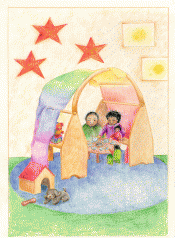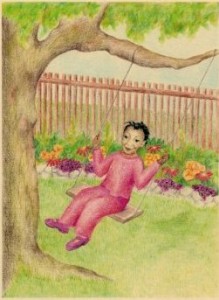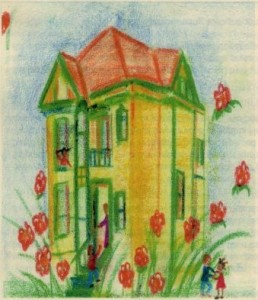Waldorf News
Self-directed play is disappearing in kindergartens

Supporting Self-directed Play, published by WECAN, arose out of two concerns. One is the disappearance of play in many countries around the world. The other concern is the danger of self-directed play disappearing in the practice of Steiner/Waldorf early childhood education. A quiet shift is taking place in Steiner/Waldorf early childhood practice away from a cornerstone of this work, the self-directed and open-ended play, towards more time spent in playful, outcome-oriented activities.
The book originated in Australia as part of a three-year cooperative working that took place from 2006 to 2009 between Renate Long-Breipohl and teachers on the theme of self-directed play, called “The Play Project.”
The Current Situation of Children’s Play
Child-initiated, self-directed play is disappearing fast from early childhood all over the world. One or two generations ago many children still lived in country or suburban areas where they were able to play outside, away from the watchful eye of parents or teachers. They directed their play themselves, exploring, seeking out hiding places, collecting treasures and thus being immersed into their own world.
Today, many educators observe not only the disappearance of play from the early childhood curriculum in public and state schools, but also an increasing inability in young children to self-initiate play and to sustain it, if they are given the opportunity to do so. In 2009 the Alliance for Childhood published a research report on play, Crisis in the Kindergarten: Why children need to play in school. The report is based on nine recent studies of the state of play in a number of American kindergartens in different states and social situations. The studies showed that play “is now a minor activity, if not completely eliminated in the kindergartens assessed.” Two to three hours is spent each day in literacy, math, and test preparation, and children have 30 minutes or less each day for play or “choice time.” Teachers mentioned that it is a major hindrance that play isn’t incorporated into the curriculum. Many classroom activities that adults describe as play are in fact highly teacher-directed and involve little or no imagination or creativity on the part of children.
Crisis in the Kindergarten and other recent recommendations on play by pediatricians raises the question: what is meant by the terms free play, child-driven play, child-initiated play and self-directed play? Similarly, what is meant by adult-directed play, play-based learning, adult-initiated activities and structured learning?
How much should the teacher lead? Is it the child who initiates play and is it the role of the teacher to enter into play situations with suggestions for extending play? Or is it the intention that the child directs his own play process from the beginning to the end without intervention by the teacher? In this case, would the teacher’s guidance of learning activities relate to other activities during the day, which then would be directed more toward the group of children, such as storytelling, or domestic and craft activities?
The answer to those questions will be different for Waldorf early education environments than for other approaches. In Waldorf early education there is a clear separation between self-directed play and the work of the teacher on the other, in which children may join. In Supporting Self-directed Play the “play research” undertaken relates entirely to the time (at least 60 to 90 minutes indoors and 60 minutes outdoors per day) in which children are the “masters” in directing their own play, while the teacher has the role of preparing the environment and safeguarding the space and time for play, but not getting involved (unless a situation requires intervention for the purpose of safeguarding play and protecting children.

Rudolf Steiner on the play of the child
A century ago Rudolf Steiner pointed to the importance of self-initiated play for young children, especially between the third and sixth year of life, and he warned of the consequences of replacing the child’s self-directed play with activities which are planned according to programs and pedagogical intentions held by adults. His reasons for suggesting non-interference of the adult in respect to child-initiated play are based on a deepening of the understanding of play in relation to three fundamental areas:
- The nature of play in early childhood as distinct from the play of older children
- The role of play in the development of the child
- The role of play in the biography of the human being
The urge to play appears in young children up to the age of five with such elemental force that one can compare it to the natural necessities of eating and sleeping. Rudolf Steiner likens the urge to play to the flow of a river, to the water’s continuous moving along in the river bed. What happens in play in not premeditated but occurs out of the spur of the moment with a great deal of willpower. The release of will through the play action is a source of joy for the child, a joy not linked to the achievement of a specific purpose. Turning to the role of play in the biography of the human being, he says:
The urge to play, the particular way in which a child plays, disappears and sinks below the surface of life. Then it resurfaces, but as something different, as the skill to adapt to life. There is an inner coherence in life throughout all its stages. We need to know this in order to teach children in the right way.
The child has a spiritual-soul activity that, in a certain sense, still hovers lightly, etherically over the child. (That is, the spirit-soul being of the child is not yet fully incarnated.) It is active in play in much the same way that dreams are active throughout the entire life. In children, however, this activity occurs not simply in dreams, it occurs also in play, which develops in external reality. What thus develops in external reality subsides in a certain sense. In just the same way that the seed-forming forces of a plant subside in the leaf and flower petal and only reappear in the fruit, what a child uses in play also only reappears at about the age of twenty-one or twenty-two, as independent reasoning in gathering experiences in life.
Play reveals its greatest importance for the human biography, in that self-directed play is a practice for and a foreshadowing of taking responsibility for one’s own life. Steiner was one of the first who spiritually discovered and publicly spoke about play as a spiritual activity and about the benefits of play for the later life as an adult.
What should educators do to guide children’s play?
- Follow the child’s lead
- Make an effort to understand children’s play as an expression of their individuality
- Not intervene unless there is a risk or danger for the child or other children
- Be active workers and become models for skill and devotion in their work
- Trust
What is revealed in self-directed play and Types of self-directed play
The longest chapters of the book are devoted to the fruits of the research from the “Play Project.” Play is an activity in which the child relates to the outer and inner world and experiences different qualities of life on earth. There are six types of play:
- Play in which the child actively explores the environment and forms mental representations of this world which are later linked to concepts.
- Play that specifically develops the coordination and dexterity of the limbs and the mastery of the body.
- Play in which the child reproduces the roles and events of everyday life and in replaying social experiences builds an understanding of the social world.
- Play in which the child expresses inner experiences and works through trauma.
- Play in which the child enters the world of images and archetypes, which are the heritage of humanity, and reproduces those images in playing out stories or producing pictures related to long times past.
- Play in which the child creates something new, actively changing the given.

Being a Play Facilitator
The final chapter contains a summary of what senior Waldorf early childhood educators shared about their understanding of play and what they have experienced in facilitating self-directed play. There are also many practical indications about setting up the environment, indoors and outdoors, for self-directed play.
Supporting Self-directed Play is a highly-recommended book for anyone working with early childhood education.
Click here for information about ordering a copy of Supporting Self-directed play
The beautiful drawings that accompany this article are reproduced with the generous permission of Sophia Project. Sophia Project serves children and families who are at risk of recurring homelessness and its effects. They are located in a low income neighborhood in West Oakland and their programs include infant and toddler program and care, early childhood education, extended hours of childcare, a before and after school program which includes both tutoring and care, artistic activities, a weekend respite program, parenting education and family support services. Working with the children and mothers in this way enhances a healthy family life and creates a firm foundation of early learning, critical to later success in school. Learn more at sophiaproject.org.
 Roadmap to Literacy Books & Courses
Roadmap to Literacy Books & Courses Storytelling Skills for Teachers
Storytelling Skills for Teachers Middle School Science With Roberto Trostli
Middle School Science With Roberto Trostli Apply Today: New Cohort Starts Nov. 2025
Apply Today: New Cohort Starts Nov. 2025 Bringing Love to Learning for a Lifetime
Bringing Love to Learning for a Lifetime Waldorf-inspired Homeschool Curriculum
Waldorf-inspired Homeschool Curriculum Train to Teach in Seattle
Train to Teach in Seattle Waldorf EC Training & Intensives in Canada
Waldorf EC Training & Intensives in Canada The Art of Administration and Leadership
The Art of Administration and Leadership Grade Level Training in Southern California
Grade Level Training in Southern California Immersive Academics and Arts
Immersive Academics and Arts ~ Ensoul Your World With Color ~
~ Ensoul Your World With Color ~ Bay Area Teacher Training
Bay Area Teacher Training The Journey is Everything
The Journey is Everything Full-Time Teacher Education
Full-Time Teacher Education Association for a Healing Education
Association for a Healing Education Art of Teaching Summer Courses 2025
Art of Teaching Summer Courses 2025 Jamie York Books, Resources, Workshops
Jamie York Books, Resources, Workshops Caring for All Stages of Life
Caring for All Stages of Life Summer Programs - Culminating Class Trips
Summer Programs - Culminating Class Trips Transforming Voices Worldwide
Transforming Voices Worldwide Everything a Teacher Needs
Everything a Teacher Needs Flexible preparation for your new grade
Flexible preparation for your new grade Space speaks. Its language is movement.
Space speaks. Its language is movement. Dancing for All Ages
Dancing for All Ages Discovering the Wisdom of Childhood
Discovering the Wisdom of Childhood Quality Education in the Heartland
Quality Education in the Heartland RSS Feeds
RSS Feeds